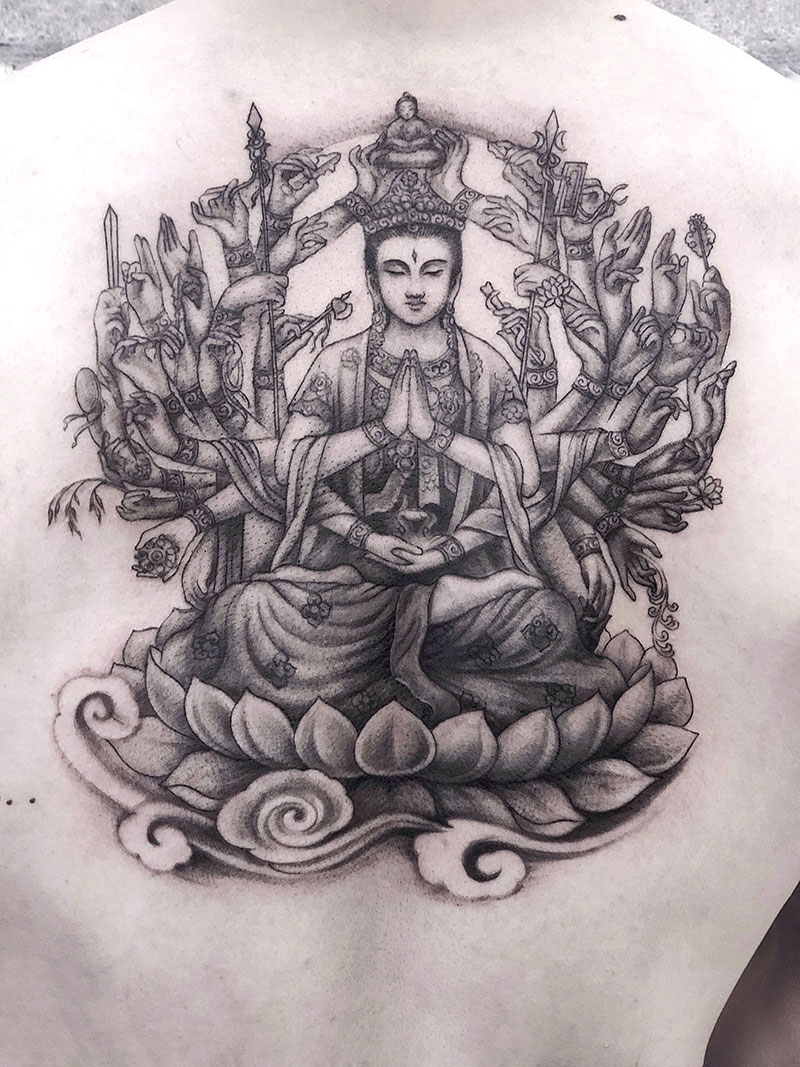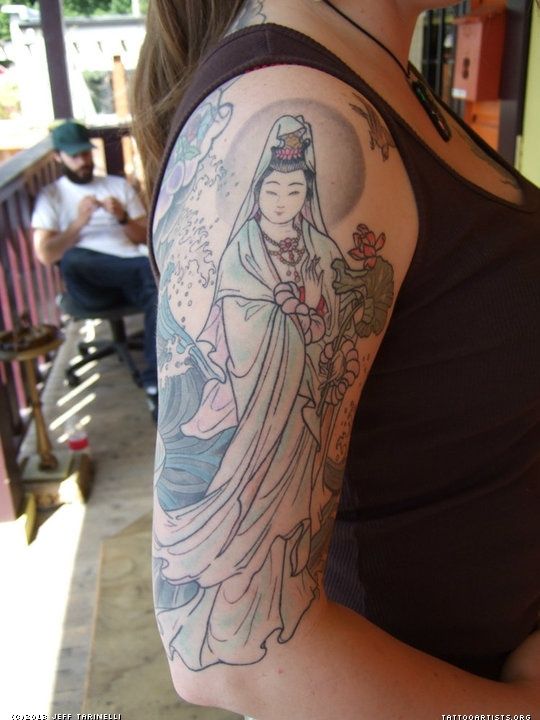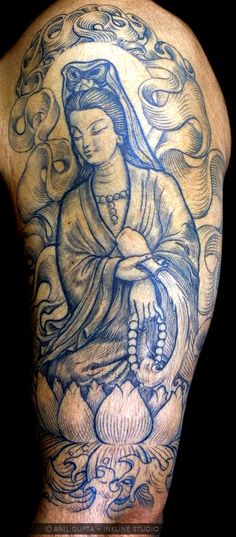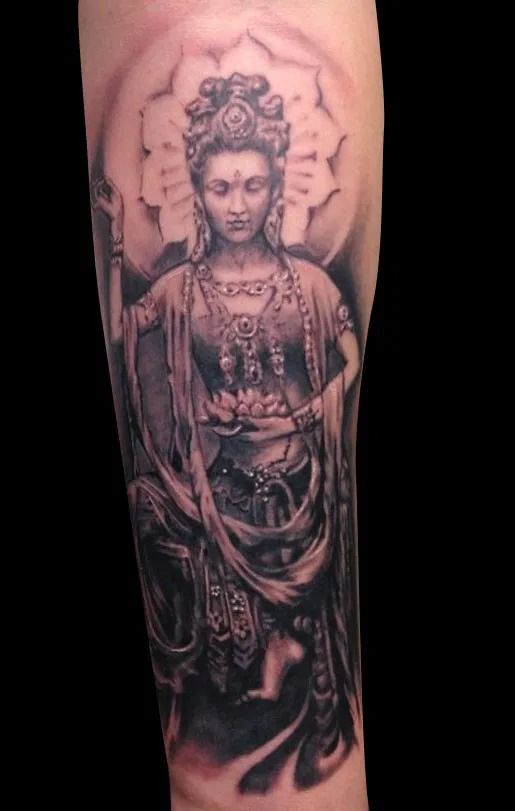Tattoos have been a form of self-expression for centuries and have evolved from being a symbol of rebellion to being an art form that represents an individual’s beliefs, culture, and personality. One tattoo that has gained popularity over the years is the Guanyin Bodhisattva tattoo. In this article with Impeccable Nest, we will explore the meaning behind Guanyin Bodhisattva tattoos and why they are so significant.
Who is Guanyin Bodhisattva?
Guanyin Bodhisattva is a revered figure in Buddhist culture, often referred to as the “Goddess of Mercy.” She is considered to be a bodhisattva, which means she has attained enlightenment but chooses to remain on earth to help others reach enlightenment too. Guanyin is known for her compassion, kindness, and benevolence towards all living beings.
What is the significance of Guanyin Bodhisattva tattoos?
Guanyin Bodhisattva tattoos are popular among those who seek to embody the virtues of compassion, mercy, and kindness in their lives. Guanyin, also known as Avalokiteshvara, is a bodhisattva or enlightened being in Mahayana Buddhism who embodies these qualities and is believed to have the power to alleviate suffering and grant blessings.
As a symbol of Guanyin’s compassionate nature, the tattoos often feature images of the bodhisattva with her many arms outstretched, holding various objects such as a lotus flower, a vase of nectar, or a willow branch. These objects represent different aspects of compassion and mercy, such as healing, purification, and protection.
The act of getting a Guanyin tattoo can also be seen as a form of devotion and reverence for the bodhisattva. It is a way to express one’s faith and commitment to following the path of compassion and kindness that Guanyin represents. In this sense, the tattoo serves as a constant reminder to the wearer to strive towards these virtues in their daily life.
Furthermore, wearing a Guanyin tattoo can also be a way of spreading the message of compassion to others. By displaying the tattoo, the wearer may inspire others to practice kindness and empathy towards all living beings. It can serve as a conversation starter about the teachings of Buddhism and the importance of compassion in our world.
In conclusion, Guanyin Bodhisattva tattoos hold deep meaning and significance for those who choose to get them. They serve as a powerful reminder to lead a compassionate life and to show kindness to all living beings, while also expressing devotion to a beloved figure in Mahayana Buddhism.
Meaning of Different Guanyin Bodhisattva Tattoos
Tattoos of Guanyin Bodhisattva are popular among those who follow Buddhist teachings or admire her qualities of compassion, mercy, and wisdom. Different Guanyin tattoos may represent different aspects of her character or symbolic meanings.
For example, a tattoo of Guanyin with a lotus flower may symbolize purity and spiritual rebirth. A tattoo of Guanyin holding a child represents her role as the protector of women and children, while a tattoo of Guanyin with a dragon represents her ability to control and transform negative energies.
Other popular Guanyin tattoos include:
Thousand-Armed Guanyin tattoo
The Thousand-Armed Guanyin tattoo is a popular depiction of the Buddhist bodhisattva Guanyin. In this tattoo, Guanyin is portrayed as having numerous arms, each holding a different implement that represents her powers to help all sentient beings.

According to Buddhist mythology, Guanyin is a compassionate and merciful bodhisattva who embodies the ideal of selfless service to others. She is believed to have the ability to hear the cries of those suffering in the world and respond with compassion and assistance. This is why she is revered by many followers of Buddhism, particularly in East Asian countries such as China, Japan, and Vietnam.
In the Thousand-Armed Guanyin tattoo, each arm represents a particular aspect of Guanyin’s compassionate nature and her willingness to help those in need. Some of the implements commonly depicted in these tattoos include a lotus flower, symbolizing purity and enlightenment; a rosary, representing the power of prayer; a vase, representing the ability to hold and distribute blessings; and a sword, representing the power to cut through ignorance and attachment.
Other possible implements include a book, representing the wisdom of the teachings of Buddha; a wheel, representing the turning of the Dharma and the cycle of rebirth; and a musical instrument, representing the power to soothe and uplift the spirits of those in distress.
Overall, the Thousand-Armed Guanyin tattoo is a powerful symbol of compassion, mercy, and the desire to alleviate the suffering of all sentient beings. It is a testament to the enduring appeal of Guanyin as a spiritual figure, and to the enduring relevance of her message of love and kindness in a world that often seems cold and indifferent.
Guanyin tattoo with a willow branch
The Guanyin tattoo with a willow branch is a powerful symbol that represents the healing and soothing abilities of Guanyin, the bodhisattva of compassion in Chinese Buddhism. This tattoo features an image of Guanyin holding a willow branch, which was often used for medicinal purposes in ancient China.
In Chinese culture, willow branches have long been associated with healing and soothing properties. They were commonly used in traditional medicine to treat ailments such as headaches, fever, and rheumatism. The flexibility of the branches made them ideal for this purpose, as they could be easily bent and shaped to fit the contours of the body.

As a result of their medicinal properties, willow branches also came to be associated with spiritual healing and enlightenment. In Chinese mythology, it is said that drinking tea made from willow leaves can help one attain immortality and enlightenment. The willow tree itself is also seen as a symbol of resilience and adaptability, as it is able to bend and sway with the wind without breaking.
Guanyin, as the embodiment of compassion and mercy, is often depicted holding a willow branch in Chinese art and iconography. This symbolizes her ability to heal and soothe the suffering of others, both physical and spiritual. By getting a tattoo of Guanyin with a willow branch, one is expressing their own desire to embody these qualities and to bring healing and comfort to those around them.
Overall, the Guanyin tattoo with a willow branch is a powerful symbol of compassion, healing, and spiritual growth. It is a beautiful and meaningful way to express one’s devotion to Guanyin and to the ideals she represents.
Guanyin tattoo with a water jar
The Guanyin tattoo with a water jar is a powerful symbol that represents the belief in Guanyin’s ability to purify impurities and cleanse the mind and body. Guanyin, also known as Avalokiteshvara, is a bodhisattva or enlightened being in the Buddhist tradition who embodies compassion and mercy.
In this particular representation, Guanyin is depicted holding a water jar, which is believed to contain the elixir of life. The water in the jar symbolizes the pure and cleansing nature of Guanyin’s compassion and mercy. It is said that by meditating on this image or having it as a tattoo, one can invoke Guanyin’s power to purify their thoughts, emotions, and actions, and to heal physical and spiritual ailments.

The water jar is also significant because it represents the idea of emptiness in Buddhism. Emptiness refers to the lack of inherent existence of all phenomena, including ourselves. By realizing emptiness, we can free ourselves from suffering and achieve enlightenment. The water in the jar, therefore, represents the potential for us to empty our minds and let go of our attachments and delusions.
In addition to its symbolic meaning, the Guanyin tattoo with a water jar can also be a beautiful and meaningful design. It can be done in various styles, such as traditional Chinese ink wash painting or modern watercolor style. The tattoo can be placed on different parts of the body, depending on personal preference, but it is commonly seen on the back or upper arm.
Overall, the Guanyin tattoo with a water jar is a profound symbol that represents the transformative power of compassion and the potential for purification and healing. Whether used as a tool for meditation or simply appreciated for its aesthetic value, this tattoo carries a powerful message of hope and transformation.
Guanyin tattoo with a pearl
The Guanyin tattoo with a pearl is a popular design that carries significant meaning in many Asian cultures. Guanyin is a bodhisattva, a being who has achieved enlightenment but remains on earth to help others attain it. She is often depicted holding a pearl, which symbolizes the treasure of wisdom and enlightenment that she can bestow upon those who seek it.
The Guanyin tattoo with a pearl is a powerful symbol of spiritual guidance and enlightenment. It represents the idea that through devotion and seeking the teachings of the bodhisattva Guanyin, one may be able to find the path to enlightenment and wisdom. The pearl that Guanyin holds is a metaphor for the wisdom and knowledge that she possesses and can share with her followers.

In addition to representing spiritual growth and enlightenment, the Guanyin tattoo with a pearl also signifies compassion and mercy. Guanyin is known as the goddess of mercy and is revered for her ability to bring compassion and healing to all beings. The pearl that she holds is seen as a representation of this compassionate nature, as it embodies the wisdom and understanding that allows her to provide comfort and guidance to those who need it.
The Guanyin tattoo with a pearl is often chosen by individuals who are seeking guidance and inspiration on their own spiritual journey. It is a reminder that wisdom and enlightenment are valuable treasures that can be attained through perseverance and devotion. This tattoo can serve as a constant source of encouragement and motivation for those who wear it, reminding them to stay true to their spiritual path and embrace the teachings of Guanyin.
Overall, the Guanyin tattoo with a pearl is a powerful symbol of spiritual growth, compassion, and enlightenment. It holds deep meaning for those who choose to wear it, serving as a reminder of the importance of seeking wisdom and guidance on our individual paths towards greater understanding and enlightenment.
Placement of Guanyin Bodhisattva tattoos and meaning
The placement of a tattoo is just as important as the design itself. The most popular placements for Guanyin Bodhisattva tattoos are:
- Guanyin Bodhisattva tattoos on the Arm – This is a common placement for those who want to show off their tattoo. It is also easy to cover up if necessary.
- Guanyin Bodhisattva tattoos on the Back – This placement allows for a larger and more detailed design. It can also be easily covered up if necessary.
- Guanyin Bodhisattva tattoos on the Chest – This placement is often chosen by women as it is a more subtle location. It also allows for a smaller design that can be easily covered up if necessary.
Things to consider before getting a Guanyin Bodhisattva tattoo
Before getting a Guanyin Bodhisattva tattoo, there are a few things to consider:
- Research – Research the meaning behind the tattoo and make sure it aligns with your beliefs and values.
- Placement – Consider the placement of the tattoo and whether or not it will affect your personal or professional life.
- Size and Design – Choose a size and design that you are comfortable with and that reflects your personality.
- Artist – Choose an artist who has experience with religious tattoos and who understands the significance behind the design.
Interpreting Symbolic Elements in Guanyin Bodhisattva Tattoos
A tattoo of Guanyin Bodhisattva, or the goddess of mercy and compassion, is an incredible way to express a deep reverence for this important figure in Chinese Buddhism. The symbolic elements of these tattoos can have multiple meanings related to independence, luck, peace, serenity, and wisdom. These symbols provide clues into the beliefs and values held by the wearer of such tattoos.
Interpreting Guanyin Bodhisattva tattoos involves examining several symbolic elements. The color used often carries significance on its own; traditionally, green symbolizes new beginnings, while pink stands for love and understanding. Various objects are also associated with Guanyin: lotus flowers brought forth her emergence from the water; red thread signifies protection; small birds perched atop each shoulder mark her receptiveness to listening to others’ wishes. A popular image seen on many Buddhist tattoos is that of Avalokiteshvara, known as the Thousand-Handed Guanyin, with 41 arms arising around her body that each represent an act of kindness directed at all beings she comes across.
The most crucial symbolism behind any image of Guanyin Bodhisattva is her compassionate nature—her ability to respond swiftly to anyone asking for help. Other common images include large eyes that suggest that she sees beyond physical appearances, as well as a fan behind her back, which may signify that she forgives wrongdoings and acts humanely even when we ourselves fail to be compassionate. By understanding these elements in detail, it is possible to gain insight into how deeply a person believes in the power and majesty of Guanyin’s caring message.
Overall, interpreting a Guanyin Bodhisattva tattoo goes far beyond deciphering the visual imagery associated with her figure. Taking note of every tiny detail lets you not only appreciate the artistry displayed on your skin but also understand what inspired it from an emotional standpoint, making each unique interpretation highly personal yet part of a wider shared appreciation of this beloved deity.
Exploring Color Choices in Guanyin Bodhisattva Tattoos
For many, tattoos are a meaningful expression of an individual’s identity and beliefs. Guanyin Bodhisattva tattoos—also known as Guan Yin Bodhisattva tattoos—are becoming increasingly popular due to their profound spiritual implications and display of beauty. While traditional designs of the Guanyin or Kannon show the bodhisattva wearing white robes, today’s tattoo enthusiasts often opt for vibrant colors that help create powerfully symbolic pieces.
A Guanyin Bodhisattva tattoo artist needs to consider several factors when developing color schemes for their clients. Color is believed to carry significant metaphorical weight in Chinese culture, so it’s thoughtfully used to communicate a story behind the design. Tattoo artists also need to account for how certain hues may interact with each other in order to create visually pleasing works of art. A highly experienced tattooist will be proficient in both aspects and balance them harmoniously.
Tattoo artists typically begin by introducing either warm or cool tones into a design, with subsequent colors being determined by preference and personal symbolism. Warm tones such as yellow, orange, red, and brown are often indicative of positive feelings such as joy and happiness. Meanwhile, cooler-hued tones like blue, green, purple, and gray represent inner peace and tranquility. Overall shades of black are sometimes utilized to bring elements together or add visual texture without disrupting the flow of color within the piece.
Gold is often used to highlight areas of importance on a Guanyin piece, typically its face or hands, since it’s considered a sacred color in Buddhism and Taoism alike. It carries strongly positive associations with enlightenment, purity, and wisdom, which beautifully complement any associated images of strength or divine power. As well as offering aesthetic advantages by providing contrast against other hues, gold has undeniably deeper symbolic motivations behind its adoption in Guanyin bodhisattva tattoos.
The choice for mixed-color backgrounds can range from photos that exhibit only a few different fundamental pigments within some selected sections all along to tremendously complex collages of various palette parts layered in seamless patterns throughout most half sleeve drawings – notably originating from cultures from East Asia where bright hues are especially valued while creating ink pieces inspired from classic paintings described by mythological stories related to this character usually depicted wearing lotus flower robes based on these legends from antiquity honoring female divinity protection aspect deeply respected by Buddhists everywhere across Tibet China Korea Japan India more … Depending upon position details provided via a customer consultation session beforehand, multiple colors could work better than one single saturated hue solution at targeting the topmost professional quality levels demanded nowadays when decorating skin through body modification art forms.
Conclusion
In conclusion, Guanyin Bodhisattva tattoos hold significant meaning for those who choose to get them. They represent compassion, kindness, and benevolence towards all living beings. It is important to research the meaning behind the tattoo and to choose an artist who understands the significance of the design. By getting a Guanyin Bodhisattva tattoo, you are not only expressing yourself but also embodying the qualities that Guanyin represents.

I am Harvey Berry, a tattoo enthusiast who has immersed himself in the diverse world of ink, passionately exploring the beauty and artistry within each tattoo. My mission extends beyond uncovering the aesthetics of tattooing; it involves sharing in-depth knowledge across all aspects of this art form.
Fueled by genuine curiosity and love for every facet of tattooing, I have diligently crafted well-researched articles, with a special focus on the Tattoo Meaning of Impeccable Nest section. Here, my aim is to help the tattoo community gain a deeper understanding of the meanings and values embedded in each tattoo.
One of my primary goals is to encourage responsible decision-making when it comes to getting inked. I recognize that choosing to get a tattoo is a significant personal decision that requires careful consideration. Hence, I provide diverse resources covering the meaning of tattoos, the tattooing process, aftercare tips, and other valuable information.
Whether you are a seasoned tattoo enthusiast or embarking on your first exploration of the world of body art, I aspire to be a reliable resource for you at every step of your journey. I hope that my extensive knowledge of tattoos, especially in the Tattoo Meaning section, will assist you in finding inspiration to express yourself through the art of tattoos.
